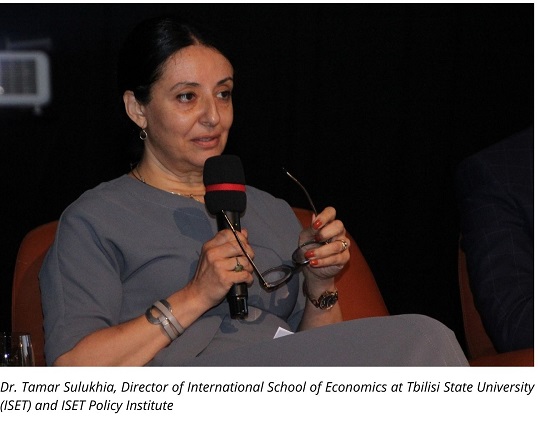Recognising, Promoting and Celebrating the Success of Women
“We have to recognize, promote and celebrate high achievements of women, as it is very encouraging for a new generation to see that many women, despite going through a very difficult path, have fulfilled their goals and ambitions. Those women managed to strike a balance between their roles and responsibilities in the family and professional advancement. The beauty of success is when you manage to level off all aspects of life - being family, friends, social responsibilities, and professional opportunities,” says Dr. Tamar Sulukhia, Director of International School of Economics at Tbilisi State University (ISET) and ISET Policy Institute.
ISET Policy Institute has developed a Gender Equality Index1 for the twelve Post Soviet Union countries (with the exception of Uzbekistan, Tajikistan and Turkmenistan) using data from the World Bank, United Nations (UN), International Labour Organization (ILO), World Health Organization (WHO) and individual countries and applying the methodology of the European Institute for Gender Equality. The index is looking at gender equality in six key domains: power, work, money, knowledge, time and health. The work domain measures the extent to which women can benefit from equal access to employment and good working conditions, the power domain studies gender equalities in decision making positions across political, economic and social spheres and the money domain measures gender equality in terms of access to financial resources.
The research shows an imbalance between the share of men and women in the share of Science, Technology, Engineering and Mathematics (STEM) professions, depriving science and technology of a greater opportunity for innovation, as increased women’s engagement often promotes greater innovation and greater creativity. Furthermore, there is evidence that when teams are gender balanced, those teams are more creative and achieve higher/better results or achieve those results in a more efficient and timely manner. Energy sector utilities having at least 30% of women in the boards have higher profit margins. These results clearly demonstrate why gender equality should concern everyone; not only women or human rights advocates. Companies with strong female leadership deliver higher return on equity; companies with female executive board members outperform those with male-only boards.
However, there are many obstacles and challenges that have an influence on women’s representation in the STEM field. Examples include the pay-gap between women and men, which lowers women’s ambition and motivation to excel in the profession, as well as the imbalance between genders in the process of recruitment. The statistics show that in many fields, including energy and other infrastructure sectors, there is a tendency and even preference to recruit male professionals rather than women. This deprives women of the opportunity to advance in their careers and improve their quality of life, but also deprives companies of the benefits of a gender-balanced team.
In the energy sector women only account for 22% of workforce, while 48% of global workforce are women. Only 6% of women are executive board members and less than 1% of women are CEOs in the oil and gas industries.
In response to the question how universities can help to improve gender underrepresentation in STEM related professions, Dr. Sulukhia noted that according to UNESCO data, 35% of students are women in STEM professions and only 30% of the world’s researchers are women. Consequently, gender inequality starts from university and is later translated into fewer women in STEM professions. However, a lot of initiatives have been directed to promote female participation and involvement in STEM sectors starting from school and universities. To make the transition from university to professional life, university professors and deans could offer mentorship and guidance to female students, as well as ensure recommendations for internships and provider more scholarships to female students, etc. A huge accomplishment would be to introduce quotas for women representation in boards and committees which is a verified standard. Moreover, other measures like making job advertisement more female friendly, saying women are encouraged to apply or including female members in job selection committees/boards might also have a positive effect.
Dr. Sulukhia says that the attraction and recruitment of women to the energy sector could be done through changing social norms, encouraging role-models, whereas for the retention of women in the sector it is very important to create female friendly, harassment free environment/facilities, equal pay policy and to retain healthy work-life balance.
EU4Energy promotes gender equality and encourages greater participation and visibility of women in the energy sector through a series of interviews on its Blog: Women in Energy. The aim of the Blog is to promote professions in the energy/power sector towards women and raise awareness about the women who contribute to its development, as well as about promising women who are taking their first steps in the profession. The Blog aims to encourage the young female generation to choose a profession in the energy/power sector and discover the advantages and adventures associated with it.
